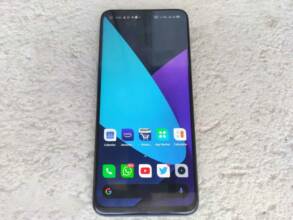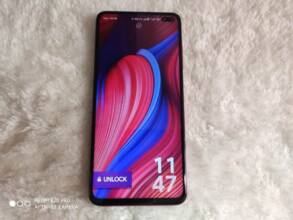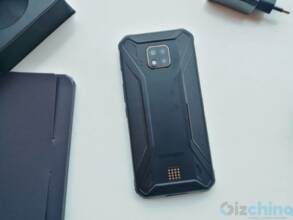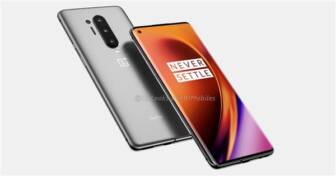Honor 8 review: All that glitters
Huawei’s Honor sub-brand has been doing well. The company has successfully expanded to Europe, dished out some good devices and built a solid reputation. Now, the Honor 8 looks to continue in building up that reputation with its unique design, dual cameras and balanced specs. But how does it fare amidst the harsh competition?
Honor 8: Design and Build
The Honor 8’s continues the tradition of Huawei devices having very good build quality. It doesn’t feel too heavy (nor too light), the glass back gives the device a very premium feel, and the overall construction of the Honor 8 feels polished.
The Honor 8’s design features a full glass back, which shines in a specific way when it hits the sun. The shiny and flashy design definitely sticks out, especially when compared to the typical metal builds on most similarly priced devices. On the rear, we have the dual camera and fingerprint sensor button, which feels great.

The power button and volume rockers are easy to reach on the right of the device, and the textured power button makes it fairly easy to identify. The buttons don’t rattle around in place and have a satisfying click, which is great after coming from the Redmi Note 2.

There are a few problems with this design however. While the rear glass panel looks nice, it’s incredibly slippery. I never actually felt it was going to slip out of my hand, but it would repeatedly slide off of sloped surfaces and my bed, much to my chagrin.
The glass build also brings about the age old issue of fingerprints and grime all over the device. While this is a non-issue on my white unit, the black and blue units especially seem to gather a lot of grime on their glass backs.
I’ve yet to break my unit, but that’s probably due to the soft wood flooring in my room. If it were any harder material, this thing would be wrecked in no time. While I can’t entirely blame Honor for choosing a glass build, I do wish they would’ve included a case of sorts like Huawei does with their devices.

Overall, it’s a very nice design, though it’s not incredibly practical. If you’ve used a Samsung S7 or S6 Edge, you’ll know how it is. The slipperiness of the device may take away from it, but the glass back is undeniably beautiful. Shame it doesn’t stay that way due to grime.
Honor 8: Display
The Honor 8’s full HD IPS display is a quality panel, even including the fact that it’s not a QHD display. Colors are very lifelike, vibrant and natural while images are sharp and crisp. Viewing angles are also impressive, allowing the device to be viewed from even the most extreme angles.

I also appreciate the device’s pre-installed blue light filter for the display. It’s a feature that should be a standard on every Android device, really. Here, it’s easily toggled from the drop down shortcut bar.

On top of that, the display’s color temperature can be changed from the settings page, and it’s much more complex compared to the color temperature tool from earlier versions of Emotion UI. It’s quite a good display, though if you’re looking for a QHD display, this isn’t the device for you.
Honor 8: Software
Ah, here we are. Huawei’s version of Android, Emotion UI, has received plenty of flak for its flaws and problems and is pretty much infamous in the world of Android. So is it really all that bad? No, not really. Not great, but not bad.

The main problem that many people have is that it’s drastically different from stock Android, mainly because it doesn’t adopt Google’s material design and has no app drawer. Instead, EmUI is similar to many other Chinese UIs where all applications are placed on the homescreen and need to be sorted manually. This isn’t really a problem as much as it is a matter of subjective taste.
EmUI also comes with multiple software features. Google’s Now on Tap is available on the device, and its presence on the device is quite convenient. Also on board is Huawei’s own Knuckle Sense, which while improved from previous iterations, is still somewhat cumbersome when it comes to actual application.

On the downside however, there’s plenty of bloatware on board for the international version. On top of Huawei’s own suite of applications, the device also comes with Google’s suite of applications AND some extra applications like the intrusive Clean Master. This is really unnecessary in my opinion. A list of the bloatware can be seen below.
- Clean Master
- Booking.com
- Dropbox
- Shazam
- WPS Office
Also, while many of EmUI’s problems have been dealt with, there are still a few more kinks that need to be ironed out like the ever present power consumption reminder that tells you to kill background apps. There’s also the issue that you can’t see certain notifications due to the text blending in with the background in the notification panel.
The settings menu holds many other functions. Aside from the prementioned color temperature tool, there’s also an option for a simple UI, a shortcut bar editor, the fingerprint sensor settings, motion controls and a bunch of other small enhancements.

There are of course still a lot of problems. It’s an incredible hassle to reset default apps, some apps like Slack need to be adjusted in the settings menu before their notifications appear, the included icon packs are average, and the lack of any material design elements makes the overall UI feel out of place next to material apps.
There’s also the issue of updates. Within the time I received the device, I received no updates whatsoever. I understand that Honor isn’t going to iron things out as quickly as a software based company like Xiaomi, but I’d like to see at least monthly updates become the norm.
All in all, I didn’t really find EmUI as bad as people claim it is, though there’s still plenty of room for improvement. It’s no stock Android, but it’s still better than many of the skins you find on Chinese phones like Elephone’s ELE UI and Oppo’s Color OS.
Honor 8: Performance
The Honor 8’s performance is quick and snappy. The device has no issues with any of your day to day activities. Snapping pictures, browsing the web and gaming were all handed very well, almost beating out other more expensive devices like the Galaxy S7.
Memory management is good with 4GB of RAM. The Honor 8 could only keep up to 10 apps open at the same time before needing to restart them. It’s close to OnePlus 3 levels of memory management, which is very good.

Gaming is another bag of worms. Generally, any game you’d want to play is more than playable on the device. However, once you start reaching games that demand a lot out of the GPU, they tend to stutter. Nowhere near unplayable, but it’s not up to the level of Snapdragon devices in GPU power.
So performance wise, the Honor 8 is good. There’s not much that the device can’t handle, and the things it struggles with are few and far between. While it’s not going to outspeed the iPhone 7, it’s more than fast enough to match up with its similarly priced brethren. If you’re a hardcore gamer however, this isn’t the best device for you.
Honor 8: Battery Life
Battery life on the Honor 8 is good. On performance mode and average use, I managed to squeeze out a decent 6 hours of screen time, while balanced mode added an extra hour on top of that.
In terms of usage, you’ll definitely be able through your entire day before needing a recharge. You’ll definitely need to charge your phone by the end however. This thing isn’t going to last until the next day. In terms of battery settings, there’s an optimize option that cuts down on processes and reduces the power consumption of apps. Dig deeper and you’ll find an ROG display option that switches the resolution of the display to 1280×720 to increase battery life.
In terms of battery settings, there’s an optimize option that cuts down on processes and reduces the power consumption of apps. Dig deeper and you’ll find an ROG display option that switches the resolution of the display to 1280×720 to increase battery life.
There’s also an extreme power saving mode which can keep the thing running for nearly an hour on 7%, alongside the already established performance and balanced options. Overall, the battery life is good. Above the average device, but below the typical battery behemoth.
Honor 8: Audio
Audio quality is a rather problematic subject when it comes to Chinese Droids. One of the most common things for a company to cut corners on is sound quality. The Honor 8 is thankfully above average in sound quality, but only just.
The bottom firing speaker on the Honor 8 isn’t the worst I’ve heard, but it’s not very good either. In terms of volume, it gets pretty loud and there’s no crackling which is great. Sound quality however is only decent with somewhat muddy bass and average clarity.

The location of the speaker also hurts the device, with it being placed in a spot that is easily blocked by your hand in many situations. Despite all this, it’s still a fairly decent speaker, it’s just not the most enjoyable setup.
The earpiece speaker is clear, though it doesn’t get very loud. It’s adequately loud for when you’re in slightly noisier environments, but it gets tough to hear when you’re in a very noisy environment, like a stadium or a bustling mall.
Honor 8: Camera
Camera quality is another issue with Chinese devices in general, though the issue is completely different compared to audio quality’s problem. Here, the main problem is companies like to stick to whatever buzzword is popular, and market it to consumers like something incredible. Then, they fail to deliver because of poor optimization and such.
Camera quality on Huawei and Honor’s devices have been pretty consistent so far, and the Honor 8 is continuing that trend. With its dual 12MP rear cameras, it manages to shoot some pretty good pictures. It also falls into the same pitfalls as most Chinese droids, that being low light shooting.
When there’s a good amount of light, pictures come out really, really well. Clarity is good, colours are spot on and there aren’t any overexposure problems that can be seen. Turn down the lights, and then you start seeing some issues.

As usual, the noise really starts to creep in once you begin shooting in low light, though it’s not really all too bad for a phone of this price. The clarity of low light pictures is decent, if slightly below average, though that’s compared to the top dogs of the camera world.

The front facing camera is actually quite good, and comes with your usual slew of software features like skin smoothening and filters. The images produced are more than good enough for posting on your social account.
Video recording on the Honor 8 is limited to 1080p at 60fps, which doesn’t too bad, up until you realize there’s no OIS. While the quality of the footage is decent, it simply too shaky to be good. Which is a shame, because this camera really does have some good potential.
The camera software is very good, with most options simple a swipe away from the shooting screen. Aside from the filters and the regular slew of camera options, there’s also a refocus mode, a food mode, a professional mode and an option to add a watermark to all your pictures. Shutter speed is quick and I never found it tough to actually snap a photo.
So to sum it up, it takes great pictures in good lighting, average pictures in low light and video shooting is not fun due to the lack of OIS. I can also firmly say it’s better than the phones in its price range, and for comparisons sake I can say that it’s better than the OnePlus 3’s camera by a decent margin.
Honor 8: Camera Gallery
Honor 8: Connectivity
When it comes to connectivity, the Honor 8 has plenty of ground covered, though not all of it. The Honor 8 covers most, if not all of the important bands, meaning it should work just fine no matter where you are.
For me in Malaysia, the device worked perfectly fine and I managed to get great speeds wherever I went, though you’ll definitely want to check with www.willmyphonework.net to make sure the device works with your carrier.

The device has dual nano-sized sim card slots, though it’s a hybrid slot so one of those will probably be dedicated to a microSD card. Speaking of which, the Honor 8 will accept microSDs of up to 256GB.
The Honor 8 supports dual-band 2.4/5.0GHz Wi-Fi 802.11 a/b/g/n/ac, with Wi-Fi Direct and hotspot capabilities. Bluetooth is v4.2, where interference issues with LTE networks should be fixed. Aside from that, there’s also NFC on board, which is good.
The satellite receiver supports GPS, GLONASS, and Beidou, so the device should be able to detect your location pretty well. The Honor 8 utilizes a USB-C port over the typical microUSB, and when connected to a computer you’ll need to change connection types through the device’s notification shade.

Another nice addition is the IR blaster, which will allow you to control certain electronic appliances like a remote controller. So it’s got just about everything covered right? Nope. Honor went ahead and decided that FM radio wasn’t a needed function, which is why it’s not here.
Honor 8 Review: Conclusion
These days, competition is rife within the affordable flagship market. This segment, which used to be home to only a few companies, is now one of the most populated. Any device that wants to succeed needs to have something warrant purchasing it over another. Thankfully, the Honor 8 manages to this splendidly.

The device’s objective cons are really few and far between. Most of the potential issues are simply a matter of subjective taste, like EmUI or the all glass design. The main problem with the device is its slippery build, which isn’t really much of a deal breaker.
Honor 8: Pros
- Glass and metal construction is unique and looks good and helps it stand out
- Build quality is good
- Crisp, clear and colourful display
- Performance is snappy and quick
- Fantastic connectivity
- Above average audio quality
- Camera is stellar in good lighting
- Battery life beats many devices in its price bracket
- EmUI isn’t a disaster.
Honor 8: Cons
- The glass build looks great, but smudges way too easily
- Glass build is also quite slippery
- The GPU is weaker than similarly priced devices
- No FM radio
- Camera is only decent in low light
- EmUI still needs more polish
- Updates aren’t all too frequent
So overall, If you’re looking for the most powerful device for your money, this isn’t where you should be looking. There are other devices in this price bracket that offer more GPU performance, namely the Mi5s and the OnePlus 3 (and more recently, the OnePlus 3T).
However, I still say the Honor 8 is definitely more than worth the asking price if what you’re looking for is a dependable device that looks great but won’t break the bank after you’ve purchased it. It’s got a great design, snappy performance and good battery life.
Honor 8: Phone Gallery
- Build Quality – 90%
- Design – 83%
- Display – 88%
- Performance – 75%
- Software – 65%
- Battery Life – 83%
- Audio – 70%
- Camera – 83%
- Connectivity – 96%
81.4 %










